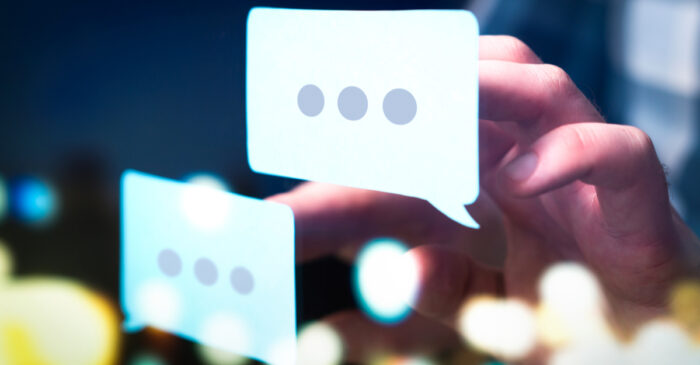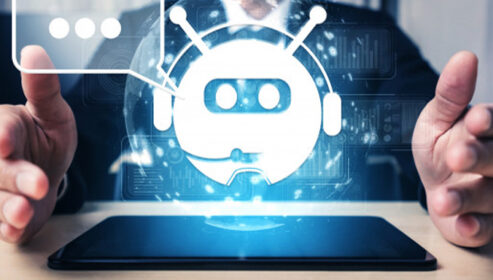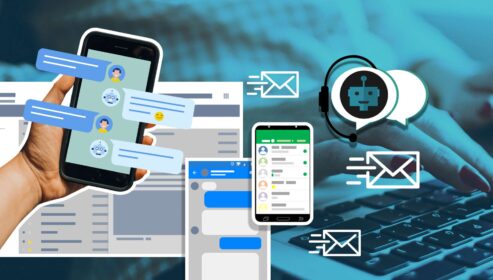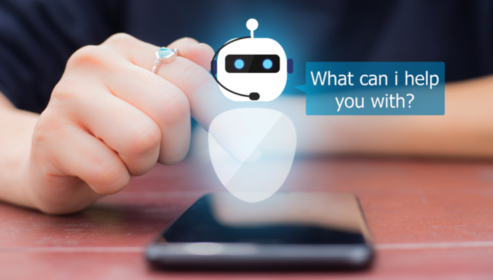Welcome to the future
Chatbots: we’ve all heard the term, interacted with them, and want to know more. What are conversational chatbots? What are they used for? How do they work? How much do they cost? So many questions and so few answers… Not anymore! Today, at Trobbit, we bring you Chatbots: An introductory guide to intelligent conversational chatbots; in it, we will answer all your questions and tell you how a chatbot can be the solution you’re looking for to stop wasting time, resources, and manpower on repetitive processes that you could optimize through automation. Are you ready? Join us! Together we will discover the fascinating world of chatbots.

What is a chatbot?
A chatbot is a software application that uses Artificial Intelligence (AI) and Natural Language Processing (NLP) to understand human requests and assist them in fulfilling them with minimal effort on the user’s part.
Sounds like Chinese to you? Don’t worry, it’s not. We’ll give you more details later, but in plain Spanish, what we mean is that a chatbot is a tool that can engage with users and help them efficiently address their needs. Here’s more about this tool. You can learn more about this tool here.
This purpose can be fulfilled through fluid and empathetic conversations that help make the interaction much closer to the user and therefore more useful. And you know why? Because they understand language and multiple languages, and that’s wonderful. Now you know what it is, but what isn’t a chatbot?
What is NOT a chatbot?
As simple as the definition of a chatbot may seem, there are multiple nuances that create confusion on this point. We know that the dividing line between chatbots and other categories is not always easy to distinguish, so today we will also tell you what is NOT a chatbot, please pay close attention:
- It is NOT a Live Chat: As mentioned earlier, a chatbot is a software application, meaning the interaction does not occur with another human being, and therefore, we cannot speak of a Live Chat if there is no human advisor behind it. A chatbot may be programmed to redirect the user to a human advisor for certain requests it cannot handle alone, in addition to offering a 24/7 service, but these features are precisely what differentiate it from other types of chat.
- It is NOT a robot: The primary difference between a bot and a robot is that the latter has physicality, and the former does not. Androids and cyborgs are types of robots, while chatbots and codebots are types of bots. Typically, robots are categorized based on their appearance, whereas bots are defined based on their functionalities. For this reason, it may be even more difficult to draw a dividing line between programs and bots than between robots and bots.
What’s a chatbot for?
From companions for Alzheimer’s patients, to an assistant that helps you classify the news that is relevant to you every morning, to a detective who, along with your children, solves the biggest mysteries of ultra-espionage, for chatbots, the sky’s the limit. Chatbots are an extremely versatile tool that allows for the automation and personalization of multiple processes. However, because we know that there are priorities and needs within organizations, today we will present the three main functionalities of a chatbot for businesses:
1. Conversational Marketing Chatbot
Conversational Marketing is a lead generation strategy based on intelligent real-time conversations. And you might think, “well, but surely this is something that my best salespeople can do.” And yes, that’s true, your marketing team and your salespeople have probably implemented this strategy for a long time. However, to what volume? With what level of detail and precision? With what speed of response? and, above all, at what costs?
Conversational Marketing aims to provide buyers with immediate, responsive, personalized, useful, and human attention. Automating this process through a chatbot will not only address all the questions we posed earlier but also advance your lead generation and sales closing process. You will be offering your potential clients and contacts the solution they are looking for, at the right time, making their visit to your website and their purchasing process much simpler, friendlier, and more interactive. Does that sound familiar? Learn more about conversational marketing chatbots here.

2. Conversational Customer Service Chatbot
You can probably guess how a chatbot can help with your customer service, right? And it’s almost the most obvious solution: making long wait times disappear for both the customer and you, ensuring that only cases that really require the help of a professional reach your advisors, automating responses to all those frequently asked questions that, no matter how much effort you’ve put into creating an entire section dedicated to them, people keep asking you over and over again… All of these are functions that a chatbot can fulfill and that will free up time, workforce, and resources for your company. Sounds good, doesn’t it? Enter the world of automated customer service here.
3. Chatbot for Conversational Sales
Customers are essentially the lifeblood of your company, and every day ideas are generated within it to find a way to optimize that journey that a buyer takes from the moment they seek information to find a solution to their needs, until they decide to move forward in choosing a product or service that your company can provide. It is here where a chatbot can become that star salesperson that supports the entire sales team, one of the most important assets of your organization.
What is its objective?
Conversational Sales aims to implement strategies aimed at accelerating the sales process, optimizing the efforts of your sales team so they can focus on what they do best: selling, and therefore bringing more and better revenue to your company. From the moment a buyer lands on your website, a chatbot through intelligent conversations will guide them through different stages until it generates a qualified sales appointment with an expert advisor, or directly connects them with one through your live chat to successfully progress towards the completion of their purchasing process.
Every day your sales team faces various challenges to optimize their time and successfully address the requirements of their prospects, generate opportunities, and achieve a significant improvement in their closing rate. Therefore, implementing a chatbot for Conversational Sales that allows your team to optimize its sales process by obtaining greater agility in each of its actions is an excellent alternative to free up that valuable time that helps them be more productive.

According to this…
Strengthening your sales team to achieve their goals is not always a simple task; however, with an intelligent chatbot, the goal appears much closer. Start paving the way towards it here.
What types of Chatbots exist?
As we’ve mentioned before, for chatbots, variety is key. There are thousands of types of chatbots that you can find in applications, websites, social networks, etc. Likewise, there are different ways to classify them; the first classification is based on the scope of their intelligence, where we find the following categories:
ITR (Text Interaction Response) Chatbots or “dumb chatbots”
As you may have guessed, these types of chatbots are not the most intelligent in their group. They are characterized by not having an Artificial Intelligence engine; they simply function with commands. Thus, using buttons and predefined responses, they follow a sequential logic that provides automatic responses but cannot deviate from the script. In this type of chatbot, interaction is directed, and when we interact with them, we notice that many nuances of what we say, such as tone, multiple connotations of words, or conversation context, are not understood.
Cognitive Chatbots or “Smart Chatbots”
This type of chatbot is much more interesting and, as you might guess, much more complex. Its operation is based on Artificial Intelligence and Machine Learning engines, or its ability to learn from interaction. Consequently, these types of chatbots are cognitive, meaning they can understand nuances in conversation tones, the context in which the conversation occurs, and respond accordingly.
Conversations with this type of bot usually occur in a much more natural way, and it’s definitely easier for the user to find the desired response because the quality of communication is much higher. Finally, this type of chatbot has a huge advantage: they can learn from their interactions; consequently, this means that their conversations will be optimized almost automatically. Of course, if you want to give it a little push in learning, you can always feed its knowledge base yourself.
Chatbots can also be classified according to their expressive medium, this classification is a bit more concrete, and surely when we tell you what it is about, you will instantly recognize them.
- Text Chatbot: communicates only through written words; it’s the traditional chat platform.
- Multimedia Chatbot: can include images, buttons, and videos, in addition to text or even voice; they tend to be more engaging.

These are just some of the possible categories for classifying the wide variety that exists in the world of chatbots. They encompass the types of chatbots that you can incorporate into your strategy so that your company and processes become more effective every day and move towards your goals.
How does a chatbot work?
We’ve already told you about the types of chatbots that exist and that one of their most important differences is the incorporation of Artificial Intelligence for their operation. So, if you want to know a little more in-depth how it’s possible for Artificial Intelligence chatbots to have such a complete understanding and be able to generate responses from scratch, we’ll tell you here.
When humans begin to develop our cognitive skills, including acquiring vocabulary and other communication skills from which we configure language, which allows us to communicate and express ourselves. Thus, to make interaction between humans and computers possible, humans developed computer languages, which are characterized by having very clearly established rules that avoid ambiguity.
Likewise, it goes in the other direction; for computers to understand us, techniques have been developed that belong to the field of Computational Linguistics (CL), within which we find Natural Language Processing (NLP) which precisely deals with solving communication problems between humans and machines. This process is fundamental for the operation of tools such as Artificial Intelligence chatbots.
It consists of two processes mainly:
- Natural Language Understanding: Natural Language Understanding is the ability of a system to process text, understand its meaning, and integrate it into an already acquired knowledge base. This ability is one of the goals pursued by Artificial Intelligence and is one of the most challenging.
- Natural Language Generation: Natural Language Generation consists of the ability to create computer systems capable of producing texts autonomously and in a format that makes sense when read by a human being. Consequently, to achieve this purpose, an interdisciplinary perspective incorporating linguistics, engineering, computer science, and psychology is necessary.

We know all this sounds a bit technical; however, this information allows us to understand how Artificial Intelligence chatbots work and also provides a clearer picture of the functions that this type of bot can perform.
How do you know if you need a chatbot?
There are some signs that may indicate that a chatbot can help you optimize, automate, or simply apply the strategies your organization needs to grow and move towards your goals.Here are some:
A continuación te contamos algunas:
- People visit your website, but your conversion rate is low.
- Your sales agents have excessively high response times, leading to losing potential clients in the process.
- Buyers don’t fill out the cold and boring contact forms on your website.
- Your visitors complain that they can’t find what they’re looking for when they visit your website.
- Customer service advisors can’t handle high-priority requests or think about improving service quality because they spend a lot of time answering frequently asked questions.
- Your customers complain that their requests, complaints, and claims are not responded to promptly.
- Your customers don’t feel well attended to, and the information they receive is not of quality.
- You don’t have a unified knowledge base between marketing and sales that guarantees your sales agents immediate access to quality information.
- Your sales team doesn’t have the capacity to handle 100% of the requirements generated by your buyers.
- You don’t promptly follow up on leads that filled out a contact form.
- Your business doesn’t operate 24/7.
If you said yes to one or more of these statements, it might be time to start thinking about implementing an Artificial Intelligence chatbot.
How to implement a chatbot?
Implementing a chatbot is simple as long as you have clarity on some points; after all, it’s best to leave the technical part to the experts. However, what you must be clear about to achieve a successful implementation is:
- Clearly define the objective you want to achieve with your chatbot: growing conversions on your website is not the same as responding to requests, complaints, and claims (PQRs). This doesn’t mean you can’t have both, but it’s best to start with one. Therefore, having a clear understanding of your chatbot’s objective is crucial for a successful implementation and to avoid surprises.
- Choose the chatbot that best meets your needs: now that you know the types of chatbots, you have no excuse. Carefully choosing the type of chatbot is crucial; you wouldn’t want to leave the visitor’s experience with your brand on your website or the delivery of specialized information about your products and services, which allows you to obtain qualified leads and streamline your sales process, in the hands of a “dumb chatbot,” right?
- A solid knowledge base: if you choose an Artificial Intelligence chatbot, you know you have the advantage that it will gradually gather information and become increasingly expert through constant training. However, a key point in implementing a chatbot is to have a solid knowledge base from the start. So, make sure you have a very clear understanding of the information that your new team member must have from the beginning.
- Analysis, feedback, and optimization: like any process or strategy within your organization, it’s important that you can analyze, provide feedback, and optimize your chatbot. Don’t launch it and abandon it; ensure its successful results through constant analysis and optimization.

What are the challenges of implementing a chatbot?
There are various challenges you’ll need to face when implementing a chatbot, and understanding them is the best way to know how to tackle them so that you can have a successful and, why not? enjoyable experience when implementing it.
- Preference for human attention: It’s normal for people to be unaccustomed to interacting with a non-human advisor; however, there’s nothing that empathetic treatment and efficient assistance can’t solve. Make sure that the chatbot you implement allows you to meet these two characteristics, and you won’t have this headache. There’s nothing more frustrating than a chatbot responding to your customers with “I don’t understand your question” or “I can’t answer you right now.”
- Concerns about the chatbot making mistakes: It’s natural to fear that, being a program, our chatbot will make mistakes. However, if you think about it carefully, you’ll have control over the tool; so, although technical failures may occur, if you train your chatbot to provide a response or teach it about your products or services, the likelihood of it delivering incorrect information to your customers is much lower than if a human did it. Thus, the key is to carefully manage the information with which you feed its knowledge base.
- Being restricted to a single channel: Well, this one is rather simple; it all depends on the type of chatbot you choose. One of the most important considerations is that the technology you choose allows your chatbot to interact with users through multiple channels. Nowadays, there are expert chatbots that perform much better on websites or even on platforms like WhatsApp.
How much does it cost to implement a chatbot?
Usually, implementing a chatbot for businesses is as relative as the functional scope and information complexity of your chatbot. Well, in the market, you can find very basic chatbots for free, others that, with a monthly service fee of a few dollars, you can implement intermediate and highly professional solutions quickly and with the support of an expert platform; obviously, there are also enterprise chatbots whose implementation value will exceed $20,000, not to mention a maintenance and support plan; and well, the price will always depend on the features it offers, its level of intelligence, the expertise advice that may be required to launch it, and even the levels of technical support.
How to choose a chatbot provider?
You already know all the ins and outs surrounding chatbots; however, how do you choose the best chatbot? The answer undoubtedly lies in your hands; however, you are not alone in this, and to guide you, we will help you with some questions that are important to answer before closing a deal with a chatbot provider, which will ensure that you are making an informed decision.
This is important…
- Is the chatbot provider specialized in what you need? If you want to implement a chatbot for Conversational Marketing or Customer Service, ideally, your chatbot provider should be an expert in the field, and their technology should be prepared for it.
- Does the provider use chatbots in their own company? It often happens that various providers claim to be specialists, but it’s curious that they don’t even have an active chatbot on their website. It’s like a piano teacher offering piano lessons without having one at their home or workplace.
- Does the provider offer a specialized solution or develop chatbots from scratch? A specialized platform demonstrates mastery of the subject and support.
- Were you able to try a functional demo focused on your needs or customized for your company? A functional demo is the best way to experience and firsthand knowledge of the service they offer.
- Is the chatbot they offer you really intelligent or is it a “dumb chatbot” that only uses buttons and predefined options? You wouldn’t want to risk having your chatbot respond to your customers with the frustrating phrase “I don’t understand what you’re asking” or even forcing them to select predefined answers and not having the freedom to express themselves and ask whatever they want at any time.
You must pay attention to every detail
- Does the chatbot they provide you learn from the user and evolve? If the chatbot doesn’t, it will be very difficult for you to improve it over time and train it to be smarter every day.
- What resources and time do you need to implement it? It’s important that the implementation is quick and high-level, without the need for coding, and also does not require a team of IT experts within your company to make it happen; this would imply the investment of many resources and would greatly increase the cost of your project; also because the focus of your business might not be the development of chatbots.
- Are you aware of the reports that can be extracted with this tool? What isn’t measured, doesn’t exist.
- Will you be able to integrate your chatbot with other solutions, systems, and third-party technologies? For a chatbot to be relevant to your company and your customers, in many cases, it will need to connect with other applications to obtain valuable information.

In summary…
As you’ve noticed, chatbots are a whole universe, one in which you now participate, equipped with all the knowledge you need to start benefiting from it. Therefore, if your organization is seeking a truly intelligent solution that allows for automation and optimization of its operations to ensure better time management and improve the quality of your service and the experience your customers have with your brand, implementing an Artificial Intelligence-powered chatbot is definitely the way to go.
In conclusion, you now know which is the best tool! If you want to obtain even more information and be assisted by a specialized consultant, contact us! At Trobbit, we are experts in chatbots for businesses powered by Artificial Intelligence; we will guide you step by step in implementing the best solution to increase your sales and automate your customer service.
Here you will soon be able to download our eBook:
Revolutionizing Customer Service in the Age of Generative AI Chatbots






